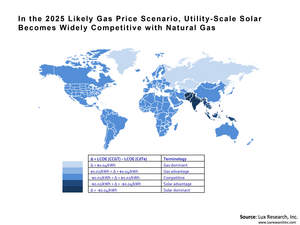BOSTON, MA--(Marketwired - Dec 3, 2013) - Far from being bulldozed by cheap natural gas, unsubsidized utility-scale solar electricity will become cost-competitive with gas by 2025, according to Lux Research. In fact, increased gas penetration actually benefits solar, by enabling hybrid gas/solar technologies that can accelerate adoption and increase intermittent renewable penetration without expensive infrastructure improvements.
The levelized cost of energy (LCOE) from unsubsidized utility-scale solar closes the gap with combined cycle gas turbines (CCGT) to within $0.02/kWh worldwide in 2025, a Lux analysis of 10 global regions found. Solar's competitiveness is led by a 39% fall in utility-scale system costs by 2030 and accompanied by barriers to shale gas production -- anti-fracking policies in Europe and a high capital cost in South America.
"On the macroeconomic level, a 'golden age of gas' can be a bridge to a renewable future as gas will replace coal until solar becomes cost competitive without subsidies. On the microeconomic level, solar integrated with natural gas can lower costs and provide stable output," said Ed Cahill, Lux Research Associate and the lead author of the report titled, "Cheap Natural Gas: Fracturing Dreams of a Solar Future."
Lux Research analysts created a bottom-up system cost model and analyzed LCOE to evaluate solar, gas, and hybrid technologies' competitiveness under different gas price scenarios across 10 regions around the world through 2030. Among their findings:
- Gas price remains a key factor. Solar can be competitive with natural gas as early as 2020 if gas prices are between $4.90/MMBtu and $9.30/MMBtu, depending on the solar resource. In the likely scenario of gas prices above $7.60/MMBtu, solar will be broadly competitive by 2025 in all 10 regions.
- Solar system prices fall to $1.20/W. While electricity price from natural gas is driven by cost of fuel, price of solar power is driven by system capex. Utility-scale thin film leads the pack with installed system prices that fall from $1.96/W in 2013 to $1.20/W in 2030, primarily due to increasing module efficiencies.
- Subsidized-to-unsubsidized transition will be turbulent. Turmoil is imminent because standalone solar will not yet be competitive when subsidies start expiring in markets like China, the U.S. and Japan. Companies will need to diversify geographically and transition to areas with fewer gas resources -- or develop hybrid systems that take advantage of low gas prices.
The report, titled "Cheap Natural Gas: Fracturing Dreams of a Solar Future," is part of the Lux Research Solar Systems Intelligence service.
About Lux Research
Lux Research provides strategic advice and ongoing intelligence for emerging technologies. Leaders in business, finance and government rely on us to help them make informed strategic decisions. Through our unique research approach focused on primary research and our extensive global network, we deliver insight, connections and competitive advantage to our clients. Visit www.luxresearchinc.com for more information.
Contact Information:
Contact:
Maggie DelRose
Lux Research, Inc.
857-284-5684
maggie.delrose@luxresearchinc.com
